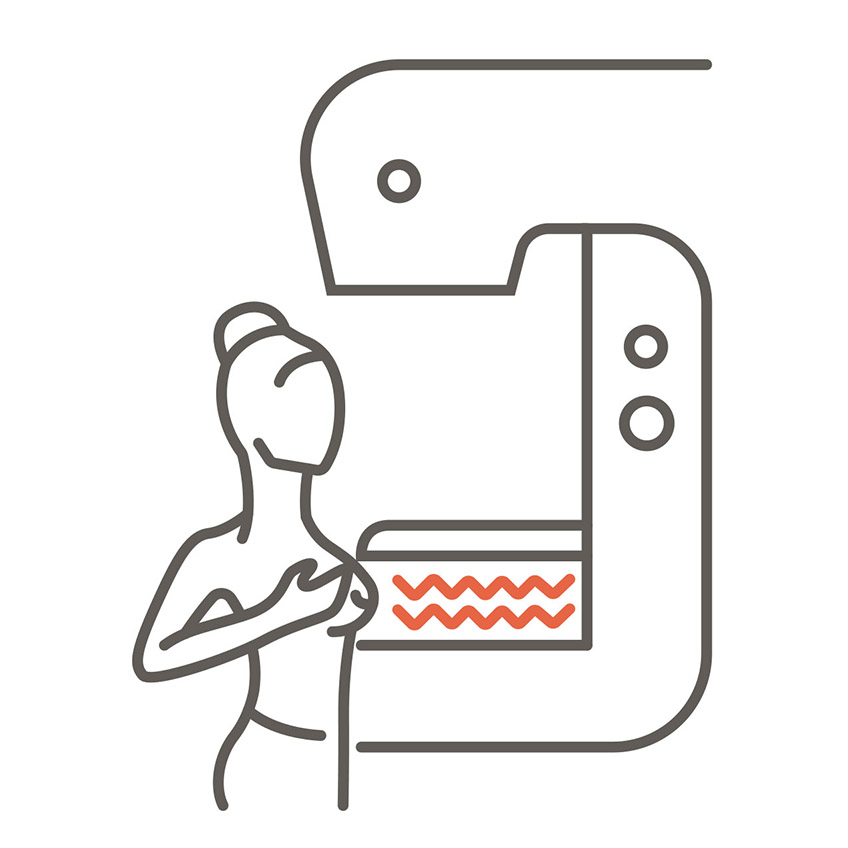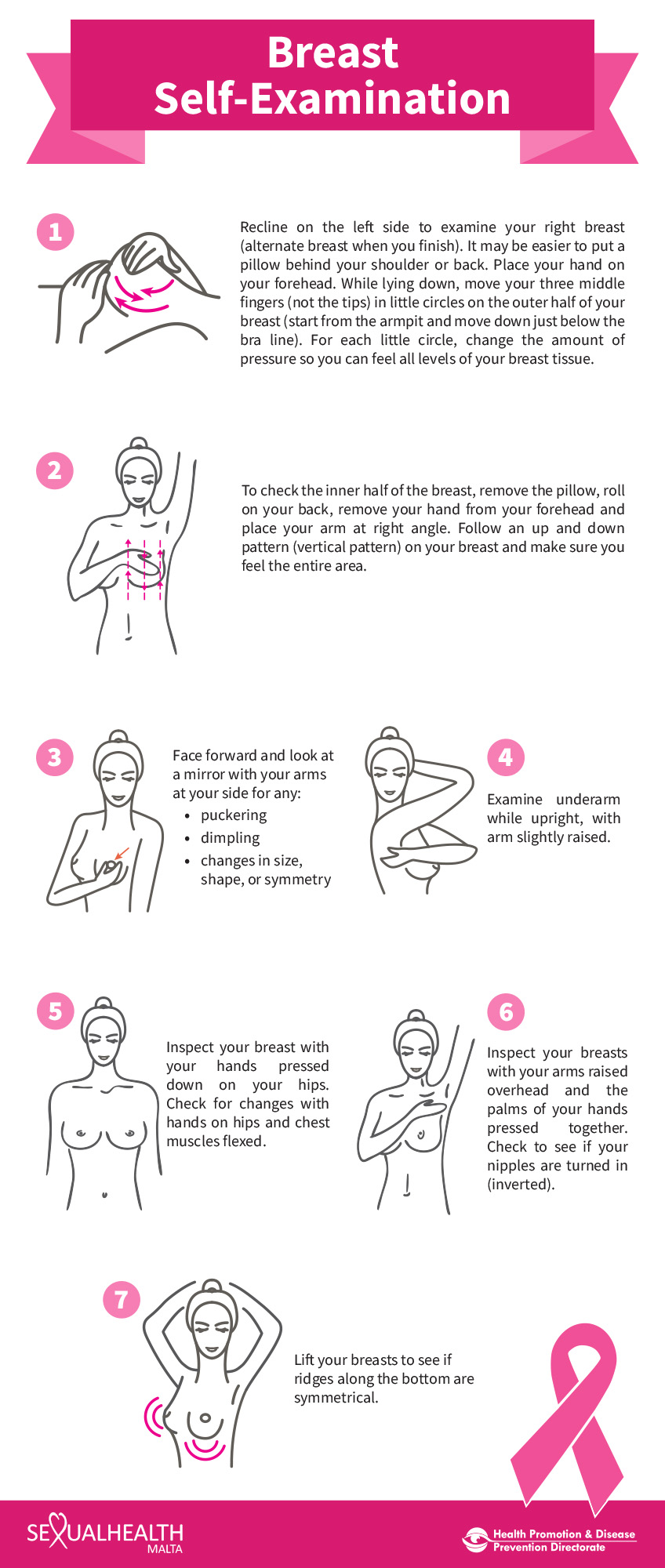Breast Cancer
Overview
Breast cancer is the top cancer affecting persons born with female anatomy worldwide. In Malta, over 300 persons are diagnosed with breast cancer every year, making it the most common cancer. On the other hand, there is a good chance of recovery if it’s detected at an early stage.
What to look for:
- Shape: variation in breast size over time, and when comparing one to the other.
- Feel: variation in breast feel (masses, heaviness, warmth).
- Skin: dimpling or retraction of the skin.
- Nipples: nipple inversion, scabs, or discharge (unless you are breastfeeding).
- Vein pattern: a noticeable increase in the size or number of veins as compared to the other breast.
 Risk factors
Risk factors
Certain factors increase the risk of developing breast cancer. However, in the majority of diagnosed women, no specific risk factor can be identified.
There are several risk factors that may increase the chance of breast cancer including:
- Being of the female gender and increasing age is a risk factor for developing breast cancer. In fact, 80% of breast cancer cases occur in postmenopausal women.
- A family history of breast cancer increases one’s risk by 2 to 3 times.
- Factors related to reproduction that increase the risks include the early onset of the first period, a late menopause, not having any children, or having children after the age of 30 years. Women using hormone replacement therapy (HRT) particularly in cases of prolonged use, are at an increased risk as compared to non-users. It is not clear if using hormonal contraceptives affects breast cancer risk.
- Breast-feeding is found to have a protective effect and reduce the risk of breast cancer.
- Overweight and obesity, physical inactivity and alcohol use have all been linked to the development of breast cancer. These factors are modifiable and by adopting a healthy lifestyle including eating a balanced, nutritious diet and regular exercise, many conditions may be prevented including heart disease, diabetes and many forms of cancer including breast cancer. In fact, regular exercise is found to reduce the risk of breast cancer by as much as one third.
- History of breast cancer or certain non-cancerous breast diseases. Persons who have had breast cancer are more likely to get breast cancer again.
Diagnosis
After examining your breasts, your doctor may refer you to the breast clinic for further tests such as mammography or biopsy.
Mammograms
A mammogram is an x-ray machine that is specifically designed to capture images of the breast to identify breast conditions that may lead to cancer or are cancerous. These images are recorded on x-ray film and are then examined by the radiologist.
The mammography test can detect breast cancer from an early stage, as it can capture growths or lumps that are too small to be felt by the patient or their doctor. It is important to remember that if breast cancer is detected early enough, there is a stronger change of beating it.
If a lump is detected, the patient will then be advised as to the further investigations required, such as a biopsy or a breast ultrasound.
Breast screening in Malta
The National Breast Screening Programme provides free breast screening to all persons with female anatomical characteristics aged between 50 and 69 in Malta every two and half years.
What are the risks and benefits?
These mammograms can detect cancer early, even when it is too small and cannot be felt by the patient or a doctor. The earlier breast cancer is diagnosed, the greater the chance for a positive prognosis, even in case there is need for a mastectomy (removal of the breast) or chemotherapy.
The main risk of breast screening is that it may pick up breast tumours that would never have otherwise caused harm or become life-threating. This may cause unnecessary anxiety and distress to the patient. There is also a small risk that a tumour is not detected during screening. Since a mammogram is a type of x-ray, it exposes the breasts to a small amount of radiation. Overall, the benefits outweigh the risks for the small dose of radiation given during the mammogram.
What happens during breast screening?
Breast screening in Malta involves having a mammogram by a radiographer who will explain the procedure to you. The breast is placed on the mammogram machine and gently but firmly compressed with a clear plate. Two x-rays are taken of each breast at different angles. Most people find the test uncomfortable or painful. The appointment lasts approximately 30 minutes.
After your breasts have been x-rayed, the mammogram will be checked for any abnormalities by two radiologists. Normal results will be sent by post after three weeks. In case there is suspicion of an abnormality, they will contact you by phone and an appointment will be given. Further investigations suggested may include a biopsy (a procedure to remove a piece of tissue or a sample of cells from your body so that it can be analysed in a laboratory). Being called back does not mean you have breast cancer. The first mammogram may have been unclear.
If you have any questions about the service, you can:
- Call the Screening Centre on 21227470/1.
- Send an email on breast.screening@gov.mt.
- Visit: 17, Lascaris Wharf, Valletta, VLT 1921.
More information can be found on:
- https://deputyprimeminister.gov.mt/en/phc/nbs/Pages/Screening-Programmes/Breast-Screening.aspx
- https://www.facebook.com/MaltaNationalHealthScreeningCentre/
Breast Self-Examination
What is breast self-examination?
This is a procedure performed by the individual to physically and visually examine changes in the breast and underarms.
Why is it done?
A breast self-exam helps you understand how your breast normally looks and feels. Breast masses are common, and some of them can be felt. The majority are benign, but one in ten is cancerous. A delayed cancer diagnosis can affect the outcome of treatment. Self-examination is not done in place of other screening tests, but in addition to them. A person should do this monthly to know what her breasts normally feel like, making it easier to detect changes when they occur. Any changes should then be reported to a doctor.
For pre-menopausal persons it should be done within the first ten days of the cycle, when the breasts are least likely to be swollen and tender. Post-menopausal persons should do this at regular monthly intervals.
How to do a self-breast exam:
The exam should be done lying down (to allow you to feel changes), then in front of a mirror (so that you may see changes). By lying down the breast tissue can spread evenly. The pictures below show how this examination is carried out. Repeat the exam every month and become familiar with how your breasts normally look and feel.
Help and Support
Further information on changing behaviour can be found on healthpromotion.gov.mt.
Reference List:
https://deputyprimeminister.gov.mt/en/dhir/Documents/Cancer/2020/cancers%20pdfs/Breast_2017.pdf
https://www.ncbi.nlm.nih.gov/pmc/articles/PMC5715522/
https://www.cdc.gov/cancer/breast/basic_info/risk_factors.htm